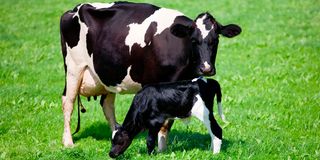Why farmer must know the maternal behaviour of cows

A Friesian cow with calf. The licking of the calf by the mother helps clear the nasal openings of foetal fluids, mucous and membranes, making way for air inhalation.
Some aspects of cattle behaviour are taken for granted until problems arise.
When a cow gives birth, it is almost automatic that she will turn around if standing, devour the placental membranes and drink the foetal fluids with gusto.
If the placenta drops while fresh, the cow will gobble it up.
Farmers work hard to prevent cows from eating the placenta.
Many believe that if consumed, the placenta would cause the animal to dry up or reduce milk output.
Fortunately, the placenta drops several hours after calving when the cow no longer has interest in it.
The second normal thing a cow does after calving is to make some fond noises and lick the calf.
She starts from the mouth and nasal areas, otherwise called the muzzle, and proceeds to the chest area before moving to the rest of the body.
By the time the cow finishes licking the calf, the newborn is ready to make attempts at standing. It also responds to the mother’s grunts with grunts of its own.
Finally the calf stands up with faltering steps before stabilising. The mother guides the newborn to the udder.
With a few misses, the calf latches onto a teat and starts suckling. Within a short time, it familiarises itself with the four teats.
Henceforth, the calf is skilled in effortlessly locating the milk tank, turning on the pipe and imbibing to its fill.
In the last few weeks, farmers have asked me questions regarding the maternal behaviour of cows.
One question was whether it is true that cows dry up or drastically reduce milk if they eat their placenta and guzzle foetal fluids.
The second was why cows eat the placenta.
Another query was whether calves can survive if the mother does not lick them.
Finally one farmer wanted to know why some cows reject their calves.
There is no scientific evidence that cows can dry up or reduce milk yield if they eat the placenta and drink the foetal fluids.
There is some thinking that the habit is a remnant of a risk management behaviour when cattle lived in the wild.
Drinking the foetal fluids and eating the fresh placenta is thought to have been a cow’s way of keeping predators off track in the wild.
Second, the foetal membranes, fluids and placenta are full of nutrients, especially minerals and proteins.
It could be a way for the cow to recoup some of the nutrients lost through calving.
Calves are likely to experience life-threatening conditions if they are not licked by the mothers within the first few minutes of birth.
The licking helps clear the nasal openings of foetal fluids, mucous and membranes, making way for air inhalation.
Licking of the chest helps to stimulate muscles and lungs to initiate breathing outside the uterus.
Licking and grunting work to enhance bonding between the cow and her calf.
Cows reject their calves for a variety of reasons.
Generally, cows that have given birth once or more times and heifers calving for the first time may reject their young if they have fearful experiences during birth or soon after.
This may be caused by bullying or harassment by workers or other cattle.
Cows that are close to giving birth should be kept alone in a quiet, cool and hygienic place in a stall or the open but with enough space to move freely.
The cows should not be disturbed or beaten when close to, during or soon after calving.
Stress caused by bullying may result in production of stress hormones that may block the production of oxytocin.
Also Read: Telling mutton from goat meat
This is the hormone responsible for milk let-down, calmness of the cow and fondness towards the calf.
Reduced oxytocin causes reduced attraction of the cow to its calf.
Diseases like mastitis, ketosis and milk fever may also make the cow reject its calf.
Farmers should always check for the diseases if a cow rejects its calf.
Mastitis causes swelling of the udder, pain and spoilage of milk.
Ketosis leads to loss of appetite, acetone odour in breath and preference of the cow to eat fodder rather than concentrate.
Milk fever in the initial stages causes trembling of the large body muscles and drying of the muzzle.
Farmers should report to their animal health service providers if they observe these signs of diseases among others.
Held upside down
First calvers may become confused after giving birth and fail to know what to do with their young ones.
Such animals should be encouraged to lick their calves by keeping the calves close to their mouths.
One should be careful to remove the calves to safety if the mother attempts to kick or bat it.
Some mothers that reject the calves may need to be tied up for the safety of the baby animal.
Should a cow fail to lick its calf immediately after delivery, the calf’s muzzle should be wiped and cleared of foetal membranes.
The calf should be held upside down with the head above the ground and gently swung to and fro to help drain excess fluid in the lungs.
Alternatively, the calf can be splashed with a pail of cold water on the chest and rubbed vigorously after clearing the muzzle of any foetal membranes and mucous.
The intervention is successful when the calf opens the mouth, vocalises and begins regular breathing.





